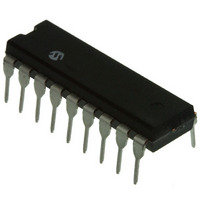PIC16F1827-E/P Microchip Technology, PIC16F1827-E/P Datasheet - Page 239

PIC16F1827-E/P
Manufacturer Part Number
PIC16F1827-E/P
Description
MCU PIC 8BIT 4K FLASH 18-DIP
Manufacturer
Microchip Technology
Series
PIC® XLP™ 16Fr
Datasheets
1.PIC16F722-ISS.pdf
(8 pages)
2.PIC16F1826-IP.pdf
(406 pages)
3.PIC16F1826-IP.pdf
(12 pages)
4.PIC16F1826-IP.pdf
(8 pages)
5.PIC16F1826-IP.pdf
(40 pages)
6.PIC16LF1827-ISS.pdf
(400 pages)
Specifications of PIC16F1827-E/P
Core Size
8-Bit
Program Memory Size
7KB (4K x 14)
Core Processor
PIC
Speed
32MHz
Connectivity
I²C, SPI, UART/USART
Peripherals
Brown-out Detect/Reset, POR, PWM, WDT
Number Of I /o
16
Program Memory Type
FLASH
Eeprom Size
256 x 8
Ram Size
384 x 8
Voltage - Supply (vcc/vdd)
1.8 V ~ 5.5 V
Data Converters
A/D 12x10b
Oscillator Type
Internal
Operating Temperature
-40°C ~ 125°C
Package / Case
18-DIP (0.300", 7.62mm)
Controller Family/series
PIC16F
No. Of I/o's
16
Eeprom Memory Size
256Byte
Ram Memory Size
384Byte
Cpu Speed
32MHz
No. Of Timers
5
Processor Series
PIC16F
Core
PIC
Data Bus Width
8 bit
Data Ram Size
384 B
Interface Type
I2C, EUSART (SCI), SPI, USB
Maximum Clock Frequency
32 MHz
Number Of Programmable I/os
15
Number Of Timers
4 x 8 bit, 1 x 16 bit
Operating Supply Voltage
5.5 V
Maximum Operating Temperature
+ 125 C
Mounting Style
Through Hole
3rd Party Development Tools
52715-96, 52716-328, 52717-734
Development Tools By Supplier
PG164130, DV164035, DV244005, DV164005
Minimum Operating Temperature
- 40 C
On-chip Adc
10 bit, 12 Channel
On-chip Dac
5 bit
Lead Free Status / RoHS Status
Lead free / RoHS Compliant
Lead Free Status / RoHS Status
Lead free / RoHS Compliant, Lead free / RoHS Compliant
- PIC16F722-ISS PDF datasheet
- PIC16F1826-IP PDF datasheet #2
- PIC16F1826-IP PDF datasheet #3
- PIC16F1826-IP PDF datasheet #4
- PIC16F1826-IP PDF datasheet #5
- PIC16LF1827-ISS PDF datasheet #6
- Current page: 239 of 400
- Download datasheet (7Mb)
24.2.3
The master can initiate the data transfer at any time
because it controls the SCKx line. The master
determines when the slave (Processor 2, Figure 24-5)
is to broadcast data by the software protocol.
In Master mode, the data is transmitted/received as
soon as the SSPxBUF register is written to. If the SPI
is only going to receive, the SDOx output could be dis-
abled (programmed as an input). The SSPxSR register
will continue to shift in the signal present on the SDIx
pin at the programmed clock rate. As each byte is
received, it will be loaded into the SSPxBUF register as
if a normal received byte (interrupts and Status bits
appropriately set).
FIGURE 24-6:
© 2009 Microchip Technology Inc.
Write to
SSPxBUF
SCKx
(CKP = 0
CKE = 0)
SCKx
(CKP = 1
CKE = 0)
SCKx
(CKP = 0
CKE = 1)
SCKx
(CKP = 1
CKE = 1)
SDOx
(CKE = 0)
SDOx
(CKE = 1)
SDIx
(SMP = 0)
Input
Sample
(SMP = 0)
SDIx
(SMP = 1)
Input
Sample
(SMP = 1)
SSPxIF
SSPxSR to
SSPxBUF
SPI MASTER MODE
SPI MODE WAVEFORM (MASTER MODE)
bit 7
bit 7
bit 7
bit 7
bit 6
bit 6
bit 5
bit 5
Preliminary
bit 4
bit 4
bit 3
bit 3
The clock polarity is selected by appropriately
programming the CKP bit of the SSPxCON1 register
and the CKE bit of the SSPxSTAT register. This then,
would give waveforms for SPI communication as
shown in Figure 24-6, Figure 24-8 and Figure 24-9,
where the MSB is transmitted first. In Master mode, the
SPI clock rate (bit rate) is user programmable to be one
of the following:
• F
• F
• F
• Timer2 output/2
• F
Figure 24-6 shows the waveforms for Master mode.
When the CKE bit is set, the SDOx data is valid before
there is a clock edge on SCKx. The change of the input
sample is shown based on the state of the SMP bit. The
time when the SSPxBUF is loaded with the received
data is shown.
OSC
OSC
OSC
OSC
PIC16F/LF1826/27
/4 (or T
/16 (or 4 * T
/64 (or 16 * T
/(4 * (SSPxADD + 1))
bit 2
bit 2
CY
)
bit 1
bit 1
CY
CY
)
)
bit 0
bit 0
bit 0
bit 0
DS41391B-page 239
4 Clock
Modes
Related parts for PIC16F1827-E/P
Image
Part Number
Description
Manufacturer
Datasheet
Request
R

Part Number:
Description:
IC, 8BIT MCU, PIC16F, 32MHZ, SOIC-18
Manufacturer:
Microchip Technology
Datasheet:

Part Number:
Description:
IC, 8BIT MCU, PIC16F, 32MHZ, SSOP-20
Manufacturer:
Microchip Technology
Datasheet:

Part Number:
Description:
IC, 8BIT MCU, PIC16F, 32MHZ, DIP-18
Manufacturer:
Microchip Technology
Datasheet:

Part Number:
Description:
IC, 8BIT MCU, PIC16F, 32MHZ, QFN-28
Manufacturer:
Microchip Technology
Datasheet:

Part Number:
Description:
IC, 8BIT MCU, PIC16F, 32MHZ, QFN-28
Manufacturer:
Microchip Technology
Datasheet:

Part Number:
Description:
IC, 8BIT MCU, PIC16F, 32MHZ, QFN-28
Manufacturer:
Microchip Technology
Datasheet:

Part Number:
Description:
IC, 8BIT MCU, PIC16F, 32MHZ, SSOP-20
Manufacturer:
Microchip Technology
Datasheet:

Part Number:
Description:
IC, 8BIT MCU, PIC16F, 20MHZ, DIP-40
Manufacturer:
Microchip Technology
Datasheet:

Part Number:
Description:
IC, 8BIT MCU, PIC16F, 32MHZ, QFN-28
Manufacturer:
Microchip Technology
Datasheet:

Part Number:
Description:
IC, 8BIT MCU, PIC16F, 20MHZ, MQFP-44
Manufacturer:
Microchip Technology
Datasheet:

Part Number:
Description:
IC, 8BIT MCU, PIC16F, 20MHZ, QFN-20
Manufacturer:
Microchip Technology
Datasheet:

Part Number:
Description:
IC, 8BIT MCU, PIC16F, 32MHZ, QFN-28
Manufacturer:
Microchip Technology
Datasheet:

Part Number:
Description:
MCU 14KB FLASH 768B RAM 64-TQFP
Manufacturer:
Microchip Technology
Datasheet:

Part Number:
Description:
7 KB Flash, 384 Bytes RAM, 32 MHz Int. Osc, 16 I/0, Enhanced Mid Range Core, Low
Manufacturer:
Microchip Technology

Part Number:
Description:
14KB Flash, 512B RAM, 256B EEPROM, LCD, 1.8-5.5V 40 UQFN 5x5x0.5mm TUBE
Manufacturer:
Microchip Technology
Datasheet:










